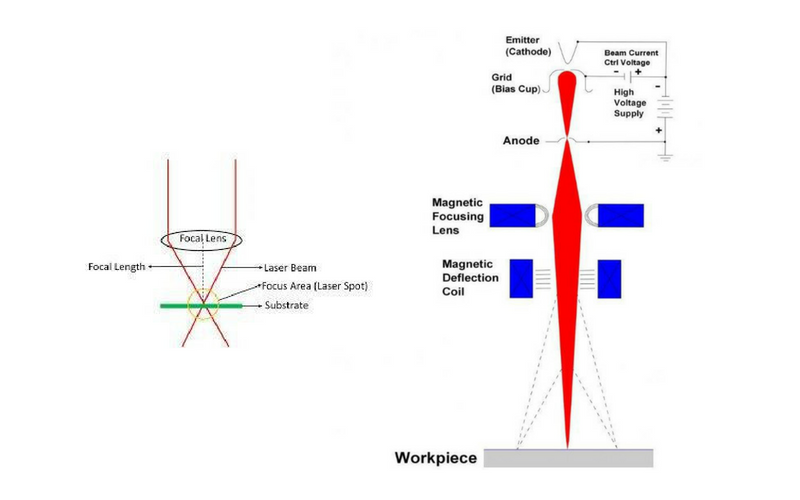
Electron Beam Welding (EBW) and Laser Beam Welding (LBW) and are both fusion welding techniques that use a high energy density beam to melt the joint of two components. Both methods have fast cycle times and produce high weld quality. They are similar and can be used side-by-side in some circumstances, but they are not identical.
What Is Laser Welding?
Laser Beam Welding uses a concentrated beam of light to affect the weld. LBW machines are highly automated and are generally linked to Computer Aided Manufacturing (CAM) design routines. Lower to Mid-range power Solid State (SS) lasers can be delivered by fibre-optic cable and are therefore suited for robotic welding applications.
The laser beam can be directed along the joint by laser scanning, allowing a greater weld speed and versatility for robot systems. Although SSLB can be conducted in air, shielding gas must be used to get good quality results, particularly in high strength materials.
The advantages of SSLB welding are faster weld speed than arc welding, with lower heat input and less distortion, they can weld in air and have no radiation risks.
The disadvantages include problems weld materials with highly reflective weld pools, such as Aluminium or Copper, very small focal range requiring accurate weld height control and weld gas shrouding at high weld speeds.
High powered Gas generated LB cannot be delivered by fibre-optic cable and must be delivered via solid glass rods and prisms, resulting in a stationary weld point in most cases. At this point there is a cross over with EBW.
What Does EB Welding offer?
Low voltage EBW (up to 60Kv) can be applied to a moving EB gun with automatic joint tracking and does not have radiation issues, however welding for high quality welds will still be done in a vacuum chamber.
For EB welds filler material is rarely used. The weld is therefore a re-melt in vacuum of the parent material(s) resulting in consistently high quality.
The energy density of High Voltage (60-200Kv)EBW is substantially greater than LBW, and as a result is used for the most critical applications where it produces higher weld speeds, greater weld depth, narrower weld bead and lower distortion.
All modern EBW equipment is fully computer controlled for weld power, focus and work piece movement. Weld data is captured in real time for quality control purposes.
In a gas laser welding machine, the laser beam is channelled through a CO2 gas chamber, generating a longer wavelength beam of 10 µm or more – falling within the infrared spectrum. These machines can generate either continuous delivery or pulse beams and allow a higher power output than solid-state laser welders. The laser is delivered to the join by means of a crystal lens, as the heat of the beam would destroy a fibre-optic cable.
Find Out More
Electron Beam Welding is one of the most reliable welding methods for complex parts and dissimilar metals, but it still requires careful design consideration to achieve optimum results.
Incorrect joint design, unsuitable material specifications and contamination can all affect your final result. Also, other welding methods, such as laser or arc welding, could be more appropriate for some applications.
To find out more, please download our Best Practice Guide – a free resource that sets out the design, fabrication and testing practices that deliver the best results from EB welding.
![]()
